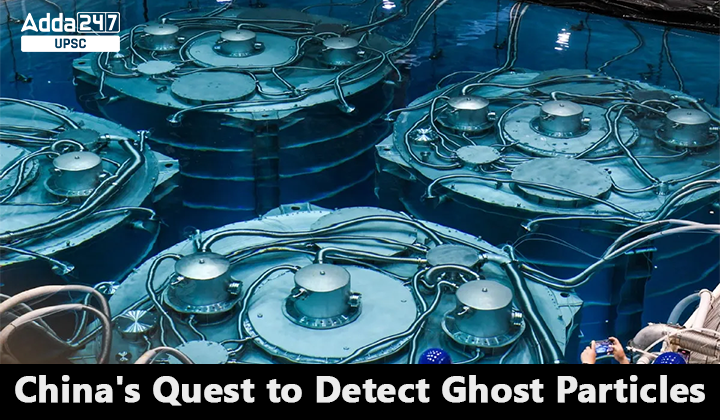Table of Contents
Ghost Particle: In the vast expanse of the universe, there exist particles that are so elusive, so enigmatic, that they have earned the moniker “ghost particles.” Neutrinos, as they are scientifically known, are among the most abundant yet mysterious entities in the cosmos. Recently, China has embarked on an ambitious endeavor to construct the world’s largest “ghost particle” detector, a telescope that will delve into the heart of the Pacific Ocean. This monumental project aims to shed light on the secrets of neutrinos and, in doing so, unlock the mysteries of the universe.
What are Neutrinos?
To grasp the significance of neutrinos, we first need to understand the fundamental building blocks of the universe—atoms. Atoms are the elemental constituents of all matter, making up everything from the soil beneath our feet to the stars that adorn our night sky. For centuries, scientists believed atoms to be the smallest particles in existence. However, the relentless pursuit of knowledge led to the discovery of subatomic particles, including protons (positively charged), electrons (negatively charged), and neutrons (electrically neutral). Neutrinos, which share certain properties with electrons but, like neutrons, possess no electrical charge, is the focal point of this scientific endeavor.
Neutrinos are intriguing due to their remarkable abundance and minuscule size. It is estimated that trillions of neutrinos pass through every individual every second, yet they remain exceedingly elusive. For a long time, scientists considered neutrinos to be completely massless, but groundbreaking research later revealed that they possess a minuscule mass. This intrinsic property, combined with its weak charge, renders neutrinos incredibly challenging to detect and study. Their interaction with other particles is exceptionally rare, earning them the nickname “ghost particles,” as they often pass through matters unnoticed.
The quest to detect ghost particles
The intriguing question is: How do scientists go about detecting particles that barely interact with other matters? Ghost particles, despite their elusiveness, occasionally engage with water molecules. It is this rare interaction has spurred China’s ambitious project of constructing an underwater telescope to detect neutrinos, often referred to as the “ghost molecule telescope.”
When neutrinos interact with water or ice, they may give rise to byproducts, such as muons, which are charged particles. Highly sophisticated underwater telescopes can record the fleeting flashes of light that these muons produce. These flashes offer one of the few avenues for studying neutrinos, providing insights into their energy levels and, crucially, their source.
As of now, the world’s most prominent neutrino-detecting facility is the University of Madison-Wisconsin’s “IceCube” telescope, nestled deep within the Antarctic ice. The sensors on the IceCube span approximately 1 cubic kilometer. However, China’s “Trident” telescope, the forthcoming behemoth in neutrino detection, is set to cover an astounding 7.5 cubic kilometers in the depths of the South China Sea. This grand undertaking will not only dwarf the current capabilities but also offer an unprecedented opportunity to scrutinize ghost particles on an unparalleled scale.
Significance of Detecting Ghost Particles
Neutrinos, often referred to as “ghost particles,” may appear enigmatic and elusive, but their detection and study hold immense significance for the world of particle physics, astrophysics, and our broader understanding of the universe. The pursuit of detecting these elusive particles is not just a scientific curiosity but a profound endeavor with far-reaching implications.
Neutrinos Defy the Rules
The most striking aspect of neutrinos is their defiance of established rules of physics. These elusive particles seem to operate in a manner that challenges our current understanding of the universe. Their peculiar properties, including their weak charge and elusive mass, perplex physicists and beckon them to delve deeper into the mysteries of the cosmos.
Origins
One of the most tantalizing questions in the field of astrophysics is the origin of neutrinos. While scientists postulate that neutrinos may have played a pivotal role in the early universe, particularly in the immediate aftermath of the Big Bang, this remains a hypothesis waiting to be validated. The detection and study of neutrinos may provide essential clues about their role in shaping the universe and its evolution.
Cosmic Rays and Beyond
Neutrinos are intricately linked to cosmic rays, which are high-energy particles that traverse the cosmos. The origins of cosmic rays have puzzled scientists for centuries. These rays, often containing neutrinos, pose an intriguing enigma that has yet to unravel. The source of neutrinos, once unveiled, may serve as a key to unlocking the mysteries of cosmic rays. Understanding the origin of cosmic rays is not just an academic pursuit but has the potential to revolutionize our comprehension of the universe and the forces that shape it.
Neutrinos and the Big Bang
To appreciate the significance of neutrinos, it is imperative to delve into their potential role in the cosmic narrative. The Big Bang theory posits that the universe originated in an incredibly dense and hot state. In these fiery moments of creation, particles, and forces emerged, setting the stage for the universe we observe today.
Neutrinos are believed to be relics of this primordial era. They may have played a fundamental role in the evolution of the universe, and understanding their properties and interactions could help us comprehend the early stages of cosmic history. While the connection between neutrinos and the Big Bang remains speculative, it is a captivating hypothesis that drives scientific exploration.
Unraveling the Mysteries
In our quest to understand the mysteries of the universe, China’s ambitious project to build the Trident telescope represents a significant advancement. Detecting and studying ghost particles, the elusive neutrinos, could potentially answer profound questions about the cosmos, its origins, and the forces that govern it. As this monumental telescope takes shape, the scientific community eagerly awaits the insights it will bring.
Shaping our Understanding of the Universe
Neutrinos have the potential to reshape our understanding of the universe. Their peculiar behavior challenges the boundaries of known physics, prompting researchers to question and refine our existing theories. By detecting and comprehending neutrinos, we can push the boundaries of scientific knowledge and potentially rewrite the rules governing the cosmos.
Cosmic Rays
The mysterious nature of cosmic rays has stymied scientists for generations. These high-energy particles, which contain neutrinos, are known to originate from somewhere beyond our galaxy. However, pinpointing their source has remained an elusive goal. The discovery of the origins of neutrinos through the Trident telescope and similar initiatives could provide essential clues to decipher the cosmic ray puzzle. This, in turn, could have far-reaching implications for our understanding of astrophysics and the broader universe.
Advancing Technological Frontiers
The construction of the Trident telescope underscores the continual advancement of technology in the quest for scientific discovery. The sophisticated instrumentation and engineering required for such an undertaking demonstrate the boundless human capacity to push the limits of exploration and innovation. As scientists build ever more advanced instruments to explore the universe, our technological prowess takes great strides forward.
Conclusion
In the depths of the South China Sea, an enormous scientific endeavor is taking shape. China’s Trident telescope, designed to detect ghost particles, or neutrinos, promises to revolutionize our understanding of the universe. These elusive entities, known for their scarcity of interaction with other particles, may hold the key to some of the most profound questions in the fields of physics and astrophysics.
Neutrinos, with their peculiar properties and cosmic connections, are enigmatic particles that defy conventional understanding. Their role in the universe, particularly their significance in the aftermath of the Big Bang and their association with cosmic rays, remains shrouded in mystery. As the Trident telescope becomes operational and enhances our capacity to detect and study neutrinos, we stand on the cusp of groundbreaking discoveries that could reshape our comprehension of the cosmos.
Initiatives like Trident serve as a symbol of the pursuit of knowledge, which highlights human curiosity and the never-ending quest to discover the secrets of the universe. With each step we take in the realm of particle physics and astrophysics, we move closer to peering into the heart of the universe, understanding its origins, and rewriting the fundamental laws that govern our existence. The construction of the world’s largest ghost particle detector signifies our unwavering commitment to exploring the unknown and embracing the mysteries that lie beyond the stars.



 TSPSC Group 1 Question Paper 2024, Downl...
TSPSC Group 1 Question Paper 2024, Downl...
 TSPSC Group 1 Answer key 2024 Out, Downl...
TSPSC Group 1 Answer key 2024 Out, Downl...
 UPSC Prelims 2024 Question Paper, Downlo...
UPSC Prelims 2024 Question Paper, Downlo...





